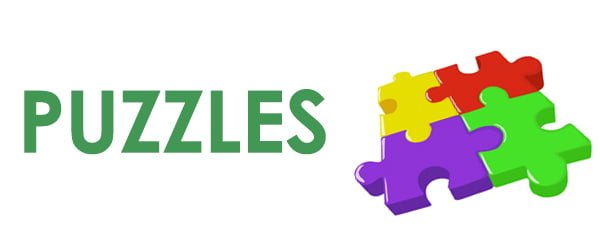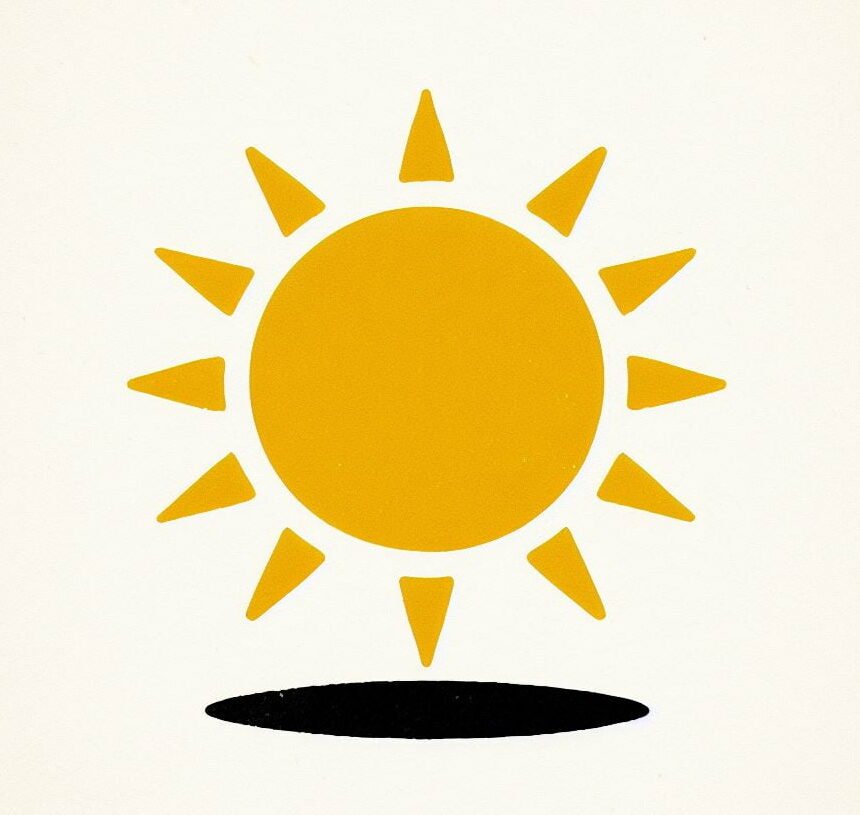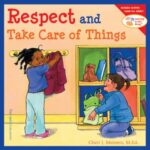Respects School Environment and Materials
What does “Respects School Environment and Materials” mean?
This skill relates to how a child treats spaces and things at school. The school environment includes all school spaces like classrooms, the lunchroom, the gym, the bathrooms, and the playground. School materials include all school supplies such as tables, chairs, books, puzzles, and art supplies. Everyone at school shares these spaces and things. Respecting the school environment and materials means taking care of spaces and things so that others can also use them. For example, a child shows respect for the school environment and materials by using classroom books gently so they don’t tear out any pages and by throwing garbage away in the trashcan. This skill shows that children are learning to treat shared spaces and things with care and are considerate of others.
What does this skill look like?

At Home
Marcus is eating the crackers his mom bought for the family. He sits on a chair in the kitchen and enjoys his snack. After he is finished, he notices a lot of crumbs on the chair. He tries to pick up the crumbs as best he can so that the chair is clean for the next person who wants to use it. Marcus puts the crackers back in the pantry so that his brother can find them later when it’s time for his snack.

In The Classroom
Samaya wants to draw a picture during free play. She goes to the art supply shelf and gets some crayons, markers, and paper. Samaya sits at a table to draw her picture and tries her best to only color on her paper so she doesn’t draw on the table. After she finishes, she puts all the crayons back in the box and makes sure to put the caps on the markers so they won’t dry out. She then returns the crayons and markers back to the art supply shelf so other people can use them.
 Children can see the value of “Respects School Environment and Materials” in the book:
Children can see the value of “Respects School Environment and Materials” in the book:
Respect and Take Care of Things
For more information about this book and other books that highlight this skill, visit our READING LIST page.
TIPS FOR FAMILIES
How can I explain this skill to my child?
You can explain this skill to your child by talking about sharing spaces and things so that we all can use them. For example, ask your child to imagine how they would feel if they shared their favorite toy with a friend and their friend threw their favorite toy across the room and broke it. They would probably feel sad or angry with their friend because they didn’t treat their toy with care and now the toy can’t be played with anymore. Let your child know that respecting shared spaces and things means treating them the same way you would want your friends to treat your favorite toy. You want to use spaces and things in a way that lets other people use them too. When we respect shared spaces and things, we all get to enjoy them!
What are some things I can do to help my child learn this skill?

Model R-E-S-P-E-C-T. You can help children understand what respect looks like by talking about and modeling examples of people respecting or not respecting places and things at home. Some ideas for scenarios that you can talk about and act out are listed below. Once you give your child a scenario and act it out, ask them, “Is this person taking good care of this place/thing?” Wait for your child to respond.
- If the answer is yes, discuss how the person in the scenario is taking good care of the place/thing.
- If the answer is no, discuss how the person is disrespecting the place/thing. Then discuss what the person could do to fix the situation and be respectful.
| EXAMPLE SCENARIOS |
| Emma is playing with toys in the living room and leaves them on the floor when she is done. |
| Ramon finishes his lunch and then wipes up the crumbs on the table with a napkin. |
| Alma spills a glass of milk in the kitchen and leaves it there. |
| Theo borrows his sister’s book and doesn’t draw in any of the pages. |
Remember that this skill can take time for children to learn. Modeling how to treat shared spaces and things frequently to remind your child what respect looks like.

Use simple organization. One way that your child can show respect for things is by putting them back where they belong after they use them. Help your child find a specific place to put different things, like books and toys. Include your child in the process of figuring out where to store things so that they feel responsible for their belongings. You can also make labels like the ones below to help your child remember where things go. Labels with words and pictures can help your child remember where everything belongs (and encourages early reading skills). By helping your child find a place for everything and encouraging them to return things to their place when they are done using them, you help them learn how to treat spaces and things with respect.


Talk it out. You can show your child by talking them through how you take care of things in your daily life. For example, when you get home and are taking off your coat and shoes, you can say things like, “First I am going to hang up my coat so it doesn’t get dirty. Then I am going to take off my shoes and put them away so they are easy to find and no one else will trip on them!” By showing your child how you take care of things in your life, you help them build this skill for themselves.
How can I encourage my child when I see them trying to learn this skill?
Acknowledge your child for their efforts! For example, tell your child, “Samaya, I think it’s great that you are putting all the art supplies back where they belong.” or “I love how hard you are working to clean up the mess you made, Marcus!” Click here for more ideas on how to encourage your child.
To download a printable PDF of the tips for this skill, click here.
TIPS FOR TEACHERS
How can I explain this skill to children?
You can explain this skill to children by talking about safety. We must treat shared things and spaces in the classroom with care so that they are safe for everyone to use. For example, if we leave books or toys on the floor, someone could trip and get hurt. Or if we damage or break things, like a chair, it would be unsafe for someone else to use. To make sure everyone has safe spaces to learn and safe things to learn with, we must take good care of all the shared spaces and things at school.
What are some examples of best practices from educational experts and fellow teachers?

R-E-S-P-E-C-T. Ask children to think about what respecting places and things means to them. To do this, it can be helpful to have them imagine how they would want their things or spaces to be treated. For example, ask the class to imagine how they would want a friend to take care of their favorite toy. For example, they might want their friend to use their favorite toy gently instead of throwing it.
Once children start thinking about how they would want their things to be treated, you can model how to treat things in the classroom. You can help children understand what respect looks like by talking about and modeling examples of people respecting or not respecting places and things at school. Write a few situations that show people respecting or not respecting places and things at school on note cards. Some ideas for scenarios are listed below. Place all the note cards in a hat or bag and ask a child to pick a card. Read the card aloud, act out the scenario, and then ask the class “Is this person taking good care of this place/thing?” Wait for the children to respond.
- If the answer is yes, discuss how the person in the scenario is taking good care of the place/thing.
- If the answer is no, discuss how the person is disrespecting the place/thing. Then discuss what the person could do to fix the situation and be respectful.
| EXAMPLE SCENARIOS |
| Emma is playing with blocks and leaves them on the floor when she is done. |
| Ramon finishes his lunch and then wipes up the crumbs on the table with a napkin. |
| Alma is doing an art project and does not clean up the glue she got on the table. |
| Theo reads a book and doesn’t draw or write on any of the pages. |

The disrespected book. You can show children what happens when we do not respect the school environment and materials by reading from a book from past classes that’s been damaged. The book may have ripped or missing pages or someone may have drawn on it. Before you begin reading to the class, let them know that the book has not been well taken care of. As you read the book stop to point out missing or torn pages or pages that have been written on. Explain to the class that these things make it hard to read the story, learn from the book, and have fun looking at the pictures. Ask the class how they feel about what was done to the book. Recognize children’s feelings and ask them what they could do to make sure none of the class’s books look like this one. Acknowledge children’s ideas about how to show care and respect. Do this activity at the beginning of the year and throughout the year to remind children of how to treat shared spaces and things so we all can enjoy them.

Share responsibility for shared things. You can help children learn how to respect things by creating a shared object in the class that requires everyone’s care and attention. For example, get a classroom plant that everyone is responsible for. Explain to the children that the plant belongs to everyone in the class and that we all must take care of it so that it can grow. Let them know that each week one child will be responsible for the plant. Each child will need to water the plant and make sure it is getting enough sunlight. If everyone in the classroom does their job and treats the plant with respect and care, then the whole class will have a beautiful plant to look at all year.

Use simple organization structures. One way that children can show respect for things is by putting them back where they belong after they use them. To help children learn to do this, set up an organizational structure for your classroom at the beginning of the year and review it with the class. Create designated areas for different types of materials, such as putting all of the books in one area of the classroom. It is also helpful to label designated areas with both words and pictures and create a color-coding scheme for different types of materials. For example, all labels for art supplies can be in one color and all labels for toys, like puzzles, can be in another color. It may also be helpful to take pictures of children using classroom supplies and post the pictures next to your labels. Below are some examples of labels for the classroom:
How can I encourage children when I see them trying to learn this skill?
Acknowledge children for their efforts! For example, say, “Samaya, I think it’s great that you are putting all the classroom art supplies back where they belong.” or “I love how hard you are working to clean up the mess you made, Marcus!” Click here for more ideas on how to encourage children.
To download a printable PDF of the tips for this skill, click here.

Start your morning with Conquering Kindergarten!
Hey teachers, want to incorporate Conquering Kindergarten into your community meeting each morning? Go to the district’s Community Meeting App to find ready-to-use slides highlighting this skill. Filter content in the app by Conquering Kindergarten or by a specific skill to get access to interactive and engaging slides tailored to the community meeting format.
To learn more about the tips and where they came from, please visit our references page.

 Children can see the value of
Children can see the value of 

